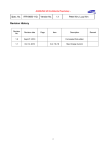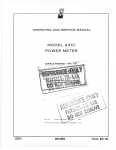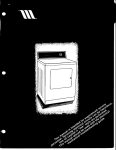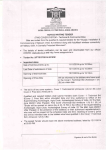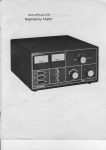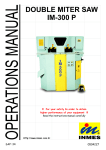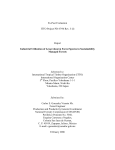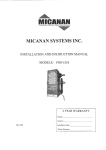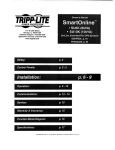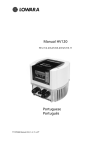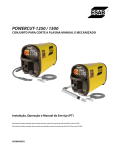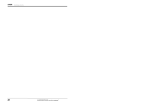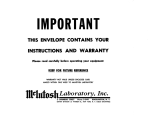Download Errata Title & Document Type: 205AG Audio Signal
Transcript
Errata Title & Document Type: 205AG Audio Signal Generator Manual Part Number: N/A Revision Date: N/A HP References in this Manual This manual may contain references to HP or Hewlett-Packard. Please note that Hewlett-Packard's former test and measurement, semiconductor products and chemical analysis businesses are now part of Agilent Technologies. We have made no changes to this manual copy. The HP XXXX referred to in this document is now the Agilent XXXX. For example, model number HP8648A is now model number Agilent 8648A. About this Manual We’ve added this manual to the Agilent website in an effort to help you support your product. This manual provides the best information we could find. It may be incomplete or contain dated information, and the scan quality may not be ideal. If we find a better copy in the future, we will add it to the Agilent website. Support for Your Product Agilent no longer sells or supports this product. You will find any other available product information on the Agilent Test & Measurement website: www.tm.agilent.com Search for the model number of this product, and the resulting product page will guide you to any available information. Our service centers may be able to perform calibration if no repair parts are needed, but no other support from Agilent is available Model 205AG Specifications SPECIFICATIONS 1 OUTPUT METER: Calibrated in volts and dbm (0 dbm = 1 mw, 600 ohms). Full scale values 65 volts, 37 dbm. Reads on 600 ohm basis regardless of output impedance selected. FREQUENCY RANGE : 20 cps ta 20 kc in three decade bands: Xl XlO XlOO 20 cps 200 cps 2 kc ta ta ta 200 cps 2 kc 20 kc Calibration covers approximately on 6 inch diameter main dial. 270 degrees CALmRATION ACCURACY: Within %2%at normal ambient temperatures. (Includes warm-up and changes due to aging of tubes and components. ) OUTPUT: 5 watts maximum into resistive loods of 50, 200, 600 and 5000 ohms. Output circuit is balanced and center tapped --any terminaJ may be grounded. FREQUENCY RESPONSE: :1 db 20 cps to 20 kc at output levels up to + 30 dbm with output meter reading held at + 37 db, :1. 5 db 20 cps to 20 kc at output levels above + 30 dbm with output meter reading held at + 37 db (reference 1000 cps). DISTORTION: Less than 1% at frequencies above 30 OUTPUT A TTENUA TOR: Provides 110 db in 1 db steps. INPUT METER: Calibrated in dbm (0 db = I mw 1 600 ohms) from -5 to + 8 dbm and in volts from 0 to 2 v rms. Voltage accuracy is :!:5% of full scale. INPUT ATTENUATOR: Extends meter range to + 48 dbm and to 200 v rms in 5 db steps. Accuracy + 0. 1 db. POWER StJPPLY: 115/230 volts %10%,50-1000 cps, 150 watts. DIMENSIONS: Cabinet Mount: 20-3/4 high, in. 15-1/2 wide, in. 12-3/4 in. deep. cps. INTERNAL IMPEDANCE: Approximately 1/6 load impedance with zero attenuator setting. Approaches load impedance with attenuator settings of 20 db or more. HUM LEVEL: More than 60 db below the output voltage or 90 db below zero level (1 mw, 600 oluns), whichever is the larger. 00090-2 WEIGHT: Cabinet Mount: Rack Mount: 56 tbs, shippingweight 49 tbs, shippingweight 78lbs. 71lbs. iii Table of Contents, List of Illustrations and Tables Model TABLE CONTENTS Section Page Section I OF GENERAL 1-1 1-2 Inspection General. IV 1-1 DESCRIPTION 1-1 rn 2-1 OPERATING Controls INSTRUCTIONS and Terminals. 2-2 2-3 Oscillator Output 2-4 Input Level Operation Meter Level Meter 11-1 ... Operation Operation. .. ll-l ll-l .. 11-2 ll-2 v CIRcurr DESCRIPTION OF IV-1 4-7 4-8 4-9 I put Level Meter Adjustment. R placement of Lamp R11 ..IV I termittent Output. 5-1 5-2 REP ~O I troduction. de CEABLE ring Model 205AG Audio Signal Generator 2-1 Output Voltage Correction Factors when using Output Attenuators ... Input Level Meter Correction Curve 1-1 . n-o n-3 Number IV -2 IV-2 -2 IV -3 V-l Information P ARTS. ILLUsTRATIONs . LIST IV -1 IV -1 IV -1 -1 IV -1 V-l V-l Number Page Title 1-1 iv ENANCE. llI-1 LIST 2-2 MAIN Page m-l 3-1 General. Number ~ ! 4-1 C binet Removal 4-2 be Replacement 4-3 Distortion 4-4 Cfl.pacitor Drive Lubrication .IV 4-5 F1:equency Ca11bration Adjustment 4-6 O~ tPUt Level Meter Adjustment 1-1 II 205AG OF Title 3-1 Bloc 4-1 4-2 Top Botto~ V~ew ViewCabinet Cabinet Removed Removed 4-3 Schematic Troubleshooting 5-1 ReplaceableParts m-l k Diagram. Diagram. .. IV-4 IV-5 IV-6 TABLES TUle 4-1 Page Chart Page I. . IV-3 V-l 00090-2 Model Sect. II Page 1 ~O5AG ~ 2-1 CONTROLS AND TERMINAILS POWER ON This switch ccntrcls the power supplied tc the instrument trom the power line. LOAD ON This switch is usedta cannect an intern 11laad acrass the OUTPUTterminals. INPUT These terminals are the input for the audio frequency INPUT LEVEL vacuum tube voltmeter in the instrument. ), ~ INPUT ATTENUATOR (DE) This switch is the range switch for the INPUT LEVEL meter and is calibrated in steps of 5 db from 0 to 40 db. FREQUENCY RANGE The position of this switch indicates the multiplying factor to be used with the frequency dia! indication. FREQUENCY Dial This dial is calibrated in cycles per second. The oUtputfrequencyis the frequency dial indication multiplied by the FREQUENCY RANGE switch position. AMPLrrUDE This control adjusts the amplitude of oscillator voltage applied to the output amplifier. The calibration is in arbitrary units. IMPEDANCE This switch selects the instrument output impedance. The available impedances are 50,200,600, and 5000 ohms. OUTPUT The instrument output appears at four terminals. The terminal marked CT is the center tap of the line matching transformer. The-4-terminal is connected to the chassis. The two vertically spaced terminals are connected to the line matching transformer through the IMPEDANCE switch. A mlanced output is obtainedfrom the vertically slXtcedterminals 00090-2 and an unbalanced output may be obtained by connecting the~terminal to one of the output terminals with the captive link provided OUTPUT LEVEL This meter indicates the voltage at the output terminals when the IMPEDANCE switch is set at 600, output attenuators OOthat zero, and the instrument is loaded with the internalor an external 600 ohm load. Under other oper~ting conditions the meter may be used as a monitor to insure constant output voltage . INPur LEVEL This meter measures the voltage applied to the input terminals and the range of the meter is controlled by the INPUT ATTENUATOR (DB) range switch. FUSE The fuseholder, located Dn the back of the chassis, contains the power line fuse. Refer ta the Table of Replaceable Parts for the correct fuse rating. Power Cable The three conductor power cable is supplied with a NEMA approved three-prong plug. The third conductor provides a chassis ground. An adapter may be obtained to permit use of this plug with twoconductor receptacles. OUTPUT A TTENUA TORS These two attenuators are used to reduce the output level in one db steps to a maximum of llO db below the output level indicated on the OUTPUT LEVEL meter. 2-2 OSCILLATOR OPERATION The procedure for operating the Model 205AGAudio Signal Generator is as follows: a. O:>nnect the instrwnent ~wer cable to a ll5/230 V alternating current power line and the output terminals to the equipment being tested. Set the IMPEDANCE switch to match the load. When the Signal Generator is operated into a high impedance Sect. li Page 2 Model load, the Load Switch must be turned on, otllerwise the Output Level M!ter and the Attenuator indications will not be correct. The Load Switch shoul,dbe oH when the instrument is connected to loads within the range of the line matching impedance!), b. Turn the power switch to ON and allow ~pproximately five minutes for the instrument to stabilize. Set the Freq. ~nge control and the frE~quency dial so that their indications whenmultiplied together equal the desired frequency. For example: Frequency dial indication 20, FREQUENCY RANGE X100, 20x 100 = 2000 cycles/second. c. Set the output at tenuators and the AMPLrrUDE control to obtain the desired output level Distortion in the output will be minimized by I~eeping the Output Level meter indication near maxim.umand reducing the output with the output attenuators. 2-3 OUTPUT LEVEL METER OPERATION 205AG For example: with an Output Level Meter indication of 40 volts and the output attenuators set at 40 db, we find from Figure 2-1 that the true output voltage into 600 ohms would be 40 volts multiplied by 0. 01 or 0.4 volts. To convert this to a voltage across a 200 ohm matched load multiply by 0. 577 or 0. 4 x 0. 577 = 0.2308 volts. 2-4 INPUT LEVEL METER OPERATION The Input Level meter is an independent audio trequencyvacuumtube voltmeter, suitable for monitor ing the output voltage of a device under test. The meter is calibrated involtsanddbabove 1 milliwatt in 600 ohms when the INPUT A TTENUA TOR (DB) switch is on zero. When making comparative measurements across a constant impedance the meter and INPUT A TTENU A TOR (DE) switch will indicate directly the change in db in the circuit under test. The Output Level meter is calibrated directly in output voltage and db above 1 milliwatt when the instrument is operating into a 600 ohm load and both output attenuators are set at zero. When using the Input Level meter to monitor a 600 ohm circuit, the power level in db above 1 milliwatt is equal to the meter indication plus the indication of the INPUT ATTENUATOR (DB) switch. With any matched load (50, 200, 600, or 500(]lohms) the output power in db above or below 1 milliwatt is equal to the Output Level Meter indication less the output attenuator settings. For examp,le: an Output Level meter indication of + 35 db and a total output attenuation of 45 db will produce an output levelof -10 dbm into a matched load. When making power measurements in circuits with impedances below 600 ohms, the absolute level in db above or below 1 milliwatt is equal to the level indicated on the meter plus the INPUT A TTENU A TOR (DB) switch indication plus a correction factor for the circuit impedance. Figure 2-2 gives correction factors for impedances between 1 and 600 ohms. Figure 2-1 is a chart of meter voltage multiplying factors for any value of output attenuation. With the IM:PEDANCE switch set at 600 ohms and an internal or external 600 ohm load, the output 1roltage will be the Output Level meter voltage ind:ication multiplied by a factor obtained from Figure 2-1 opposite the total output attenuation. For e~a.mple: with the output attenuators set for 40 db aU Output Level meter indications should be multiplied by .01 to obtain the true output voltage into a 600 ohm load. The input voltage level for any range of the INPUT A TTENUA TOR (DB) switch is the voltage indicated by the Input Level meter multiplied by the factor indicated below for the particular range of the INPUT ATTENUATOR (DB) switch in use. To obta in the true output voltage into a 50, 200 or 5000ohm load the following factors must be ~Lpplied to the true voltage across a 600 ohm matched load. Laad Impedance 600 Ohm Voltage Multiplying Faetor 50 0.289 200 0.577 5000 2.89 00090-2 Mode1205AG Sect. n Page 3 +30 ~ CD a I z Q 1u w cc cc o U +20 cc w 1w ~ 1:) 0.. z -+10 100 10 IMPEDANCE-OHMS :} Figure 2-2. Input 'Level Meter Correction Curve 00090-2 1000 ~ Sect. rn Model 205AG Page 1 ~ 3-1 GENERAL The Model 205AGAudio Signal Generator consists of an oscillator, an amplifier, output meter and attenuator, line matching transformer, and a conventional power supply (see Figure 3-1). The oscillator section (tubes VI and V2) is a resistance-tuned type circuit. Basically, this oscillator is a two-stage resistance-coupled amplifier which is caused ta oscillate by the use of a positive feedback network. This network is a frequencyselective resistance -capacity combination which controls the frequency of oscillation. By using a variabIe tuning capacitor for the capacity of the network, it is possible to tune the oscillator over a wide 10:1 range; and by using a switching arrangement to select different values of resistance for the network, several ranges are given ta the oscillator. Negative feedback is used in the oscillator section in order to minimize distortion and to obtain a very high order of stability .The amount of negative fee'dback is determined by a resistance network, one element of which is non-linear (the 3-watt lamp in the cathodeof VI). This element controls the amount of feedback in accordance with the amplitude of OScillation and consequentlymaintains the amplitude of oscillation substantially constant over a wide fre quency range. The negative feedback also keeps the operation of the system on the linear portion of the tube characteristic. The amplifier section consists of a voltage amplifier tube directly coupled ta a phase inverter which drives the push-pull output tubes. The tertiary winding on the output transformer provides negative feedback for the amplifier . The output meter and attenuator section is made up of an average reading type voltmeter and two bridged T-type attenuators. The attenuators and voltmeter are connected between the output transformer secondary and the primary of the line matching transformer. A full-wave rectifier and a dc milliammeter calibrated in volts and decibels mak.e up the Output Level meter. The line matching transformer is used to change the 500 ohms line impedance to 50, 200, 600, or 5,000 ohms output ïmpedance. The Model 205AGalsoincludesanInput Levelmeter which is of the average re spondingtype. The meter consists of a two stage amplifierwith negative feedback., a full-wave rectifier and a dc milliammeter calibrated in volts and decibels. --0 I MATCHING LINE -.- -.- r-.- r-+- -OOT 0TRANS. -0G -"OOTPUT @ 0-- Ra IHPIJT 0-G Figure 3-1. Block Diagram Model 205AG 00090-2 115/230 V ': Model 205AG Sect. IV Page 1 ~ "; ic" 4-1 CABINET REMOV AL NOTE Removefour screws from the rear of the cabinet and remove the rear cover. Place instrument on its back, and loosenthe two screws located on the underside of the front ~nel bezel. Free cabinet and lift from instrument. 4-2 CAPACITOR a. Checkfor proper setting of diaIon shaft. At one end of the frequency dia! will be either a small dot or an extra line. This should be under the indicator hairline when the tuning capacitor is at that end of its travel. This may be adjusted by loosening set screws on one side of the coupIer behind the panel, then rotating the dial until correctly lined up. Check and tighten al! set screws in the dial drive mechanism. DISTOlTION Excessive distortion may be caused by detective tubes, open by-pass capacitors, and low voltages. 4-4 The frequency calibration will be correct only when the shields around and above the main tuning capacitor are firmly in place. Using a gentIe airstream, blowout any dust that may be present on the tuning capacitor . TUBE REPLACEMENT The tubes in this instrument may be replaced with any tube having EIA standard characteristics. Whenever a tube is replaced, with the exc.eption of V7 or VB, the distortion should be measured to see that it does not exceed the specifications. When tubes V7 or VB are replaced it may be necessary to adjust the zero setting of their respective meters. 4-3 For all adjustments the output must be loaded with the internalload. Turn the LOAD switch ON. DRIVE b. Turn on the instrument and allowat minutes lor it to warm up. least 30 LUBRICATION The capacitor drive should be luhricated once a year . Remove the cover plate from the top of the capacitor shield. Put one drop of light oil on each of the bearings on the sma11 gear shaft at the top of the drive. The capacitor 00.11hearings do not need luhrication. Set to X10 range and dial to 20. Set the output meter to 50 volts. Change dia! setting to 200. The paneloutput meter should then read 50 volts %2volts and the frequency should be 2000 cps %2%. H OOthfrequency and amplitude are in error, adjust Cl and C22for the best c ompromise betweencorrect frequencyand correct amplitude. 4-5 d. FREQUENCY CALIBRATION ADJIUSTMENT The range switch resistors Hl to H6 inclusive in conjunction with tre tuning capacitor assembly Cl and C2. determine the frequency of the oscillation of the unit and also aifect the amplitude. If the output frequency is not within 2% of that indicated by the dial. or li the amplitude varies more than :!:1/2 db from 200 to 2000 cps. the following procedure is recommended. 00090-2 c. Check tracking of the rest of the frequency djal. If there is no constant error in tracking, proceed with the next step. If there is a constant error , proceed with one of the following methods, whichever is the easiest. 1. Loosen set screws and reset the dial to take the error into account, then repeat steps b and c. Tbis metbod is best tl the other ranges also have a constant error in the same direction. Sect. IV Page 2 2. Changethe srnal1padding resistors in series with the precision resistor on the range switch. :[ncreasing the va1ue of the resistor by 10,000 ohms wi11 1ower the frequency of the range approx~Lte1y 1%; decreasing the va1ue of this resistor wi11 raise the frequency of the range. * Hetrace steps a through d. e. When the XlO range bas been properly a.djusted, the other ranges may be adjusted as :follows: Model 4-7 INPUT 205AG LEVEL METER ADJUSTMENT This meter is adjustedas follows: ( a. With the instrument operating, short circuit the Input Terminals. Adjust the meter pointer to zero with zero adjustment screw on the meter . b. Connect the input terminals to the Output terminals and set the instrument controls as follows: 1. X100 range Changethe padding resistor in series with 1:hepre cision resistor. A change of 1000ohms wil:L change the frequency approximately 1%on this range. Then 20,000 cycles on the dial is corrected by varying C-7. A changeof 50 ta 200 pf is usuallyaldequate. 2. XI range An increase of IOOKohms in the padding resistor will decrease frequency approximately 1%on this range. There may be a small tracking error (less than 2%) at the top or the bottom of the X;l range. This is normal to the instrument and cannot be eliminated. f. If satisfactory calibration cannot be obtained in the above manner, it may be neceslsary ta return the instrument to an authorized re~ir station or the factory . 4-6 OUTPUT LEVEL METER ADJUSTMENT The procedure for adjusting the Output Level meter is as follows: a. With the instrument operating and Vol. control at zero, adjust the meter pointer to ze~rowith zero adjustment screw on the meter. b. Connect an accurate vacuum tube voJltmeter across the 600 ohms output terminals 11lith the 600 ohms internalload switched on. Set the instrument for 100 cycles/sec. output, zero attenuation, and adjust the Vol. control until the external voltmeter indicates 55 volts. Adjust the variabIe resistor R29 until the Output Level meter iTJIdicates exactly 55 volts. The resistor R29, which is reached through a hole in the back of the chassis, can be turned with a screwdriver . * Up to 1% change in frequency on any ran~e may be made by adjusting only one of the two range re sistor padders on that range. If a greatler frequency change is needed, adjust both padders. If this is not done, the relative amplitude b,etween ranges will be affected. The Input Level meter should indicate zero db with the controls set as above. Jf the meter indication is incorrect, ac;ijust the variabIe resistor R417to correct the meter indication. The variabIe resistor R47 is reached through a hole in the lef t side of the chassis. (Instrument removed from cabinet. } c. After the zero db level is in adjustment, change the attenuatars ta 4l db and 5l db which will indicate + 5 db and -5 db respectively; If the m~ter tracking at these points is nat satisfactory, then the 6B9-tu~-sllg.\1ld-re...r.ep]a ced,-and,"the.-a.00.v.e ..adj.ustments..r.epeated. 4-8 REPLACEMENT OF LAMP R11 The 3-watt lamp RU is operated at a very low level and should have an almost infinite life. Therefore, the lamp should not be changed indiscriminately. However, should the lamp require changing, it is necessary to measure the ac voltage from the junction of R58 and C4 to the chassis with the new lamp in the circuit. This voltage should be measured with a high impedance vacuum tube voltmeter such as Hewlett-Packard Models 400C, 400D, or 4l0B. Ta make this measurement and adjustment, the instrument must be remaved fram the cabinet. Set 00090-2 Model Sect. 205AG the oscillator frequency to 1000cycles/sec. and vary the resistor Rl9 so that 21 to 25 volts is ol:tained. The resistor R19 is mounted on the shield surrounding ~e Freq. Range Switch. INTERMITTENT "Jumpy" output accompanied TABLE by fIash- 4-1. 3 A short in the back two sections of the main tuning capacitor will prevent the circuit from oscillating. Any such short should be cleared as explained above. OUTPUT or intermittent Page ing of the 3-watt oscillator lamp (RIl) is a reliable indication of a short in trimmer capacitor Cl or in the first two sections of the main tuning capacitor . If these symptoms occur, search out and clear the short with a weak air jet or other means. Do not bend the capacitor plates because bending capacitor plates will destroy the frequency calibration. 1! the voltage cannot be brought within the 21 to 25 volts range by means of R19, the new lamp should be rejected in favor of another. 4-9 IV TROUBLESHOOTING CHART The following if; a listing of possible symptoms, causes and remedies SYMPTOMS Instrwnent inoperative (Indicator lamp won't light, no audio output) Instrument inoperative (Indicator lamp lightsl no audio output) REMEDIES CAUSES Blown Clear short circuit and replace fuse . fuse. Detective tube. Check the 5U4GA/B tube tirst, Replace tube. Short circuit in DC power circuit capacitor. Replace capacitor . Short circuit in C2 (two rear sections) Clear the as outlined short circuit in Pa.ragraph 4-9. Intermittent output Capacitors C3, C4, C5, ca or C9 intermittently open. Replace capacitor . Short circuit in C2 (two front sections) or CL Clear the as outlined 4-9". Output Level Meter inoperative. 6H6 tube V7 detective. Replace tube . Excessive distortion. Defective Replace tube. 00090-2 tube. short circuit in Paragraph Open circuit in capacitor CIOabc, C15, C16, C17, or C18. Replace capacitor. Defective output or line matching transformer Replace transfarmer . ~ Model 205AG Sect. IV Page 5 I , 1 lJII,"l",Ii","J'..lidi'" "Uic~""",ji d,". MODEL 205AG AUDIO SIGNAL GENERATOR Manual Serial Prefixed: 012Manual Printed 5/61 To adapt this manual to instruments with other serial prefix es check for errata below, and make changes shown in tables. Instrument Serial Prefix Make Manual Changes Instrument Serial Prefix 6 All CHANGE 'v Paragraph 4- 7, step b, Change the setting #1 v CHANGE #2 CHANGE #3 CHANGE #4 switch to 9!.!' . Paragraph 4-7, line #5 of step c, Change to read: "diodes CRI, CR2, CR3, and CR4 should be replaced and the above adjustments repeated. " The 205AG contains two terminal boards on which are mounted a variet y of small parts. The boards used in earlier instruments (24-terminal board Stock No. 2G-75A; 14-terminal board Stock No. 2G-75B) utilized solder lugs to mount parts. The boards used in later issue instruments, having serial prefix number 151-(large board Stock No. 2G-75C; small board Stock No. 2G-75D) are directly interchangeable, and the etched-circuit board will be supplied as a replacement part for both types. v Figure 4-3, Change V3 ta read, "6SQ7". Table of Replaceable Parts 1/ Was C19, Capacitor -fixed, 20 Jlfd, 50 vdc Mfr. , 37942, ~ Stock No.0180-0026, TQ-1, v CHANGE of LOAD Make Manual Changes Now C19, Capacitor -fixed, 20 j:Lfd, 50 vdc -Mfr. , 56289, (6j! Stock No.0180-0049, TQ-1, RS-1. RS-1. Table of Replaceable Parts Delete the following: Spring, Gompression, Stock No.1460-0019, 1 ea Vernier Disc, Stock No. G-14A, 1 ea Vernier Disc, Stock No. G-14B, 1 ea #5 Add the following: Disc Ass'y Vernier Drive, Stock No. G-14J, Mfr. 28480, TQ-l Bearing Capacitor Drive, Stock No. G-36J, Mfr. 28480, TQ-l Spring Thrust, Stock No. G-91A, Mfr. 28480, TQ-l CHANGE 8/13/62 #6 " (9-1117) Table of Replaceable Parts Was Attenuator, output, complete Now Attenuator, output, complete ltJ!)Stock No. 2AG-34 ltJ!)Stock No. 2AG-34A MODEL 2O5AG AUDIO SIGNAL GENERATOR Manu.:l1 Seria1 Prefixed: Manua1 Printed: 5/61 012- Ta adapt this manual ta instruments with ather serial prefix es check far errata below, and make changesshawn in tables. Instrument Serial Number Instrument Serial Number Make Manual Changes I CHANGE 5667 to 6236 1 4688 ta 5666 1, 3, 4, Below 3.4.5.,6 5, 6, 7 4688 1 R29: Change to 500 ohms, ~Stock No. 2100-0011. R53: Change to 22K ~pms, ~Stock No.0690-2231. Add R54: 22K ohms, ~Stock No.0690-2231. R62,63: De1ete CR1 to CR6: Delete Add V7, 9: Type 6H6 tubes. Add R59: 7 ohm resistor, connected in series with Change to 27.5K ohms, ~Stock 2 R30: Clli\NGE 3 11: Change to GE-47 lamp, ~Stock No.2140-0009. Add R56: 33 o9~s resistor in series with 11. Lens: Change q;, Stock, No. to 1450-0026. Lampholder: Change (hp Stock No. 1450-0027. CIIANGE 4 C19: H61: UD Change Chan~e to to V9, heat er No.0730-0048. CHANGE 6/8/62- Make Manual Changes 1000 pf. 100 ohms. (over) pin 7. ?tlanual Instrument Serial Number Changes Model 20SAG Page 2 Instrument Serial Number Make Manual Changes Make Manual Changes 8312 to 8462 1, 2 5667 to 6236 I, 7712 to 8311 1,213 4688 to 5666 1,3,4 7612 to 1,2,3; Below 4688 8 7711 6237 to 7611 CHANGE 4 1, 3, 5 4, Change value C19: Change to to 25.2K 1000 ohms. Change to 82,500 ohms. Change to 825K ohms. Change to 8.35 M. H7: 5000 ohm potentiometer H8: 50Kohmpotentiometer H9: 500K ohm potentiometer Change to 1.2M. H58: H61: SI: Change Delete Change to 39K switch adjustment tuning oscillation between between between l~o. to Hl potentiometers capacitor asse111bly of the unit following , 2AG-19W. resistors output frequency the amplitude H4 and ground. and ground. H6 and ground. H5 ohms. 1tIp Stock range 5, 6, 7 pf. R24: The 5, 6 5 H30: H4: H5: H6: Add Add Add 3, 4, is to H6 H7 Cl to and also and not within more tl;an varies procedure is inclusive and H9 inclusive C2, determine affect the the individual range in conjunction the frequency amplitude. If 2% of that indicated z.1/2 db from 200 to with of the the the by 2000 the dial, cps, the the tor internal voltage or recommended: IAIPORTANT For Turn all adjustments panel load measurements The in this frequency around the above will the main Blowout any dust that Use I) a Check gentIe for air proper st~!~~~ trequency dial Check and 2) warnl Turn up . 3) Set potentiometer the output paneloutput frequency compromise 6/8/62- UD will be under end of on one until to be tuning may setting be all be either set instrument XIO R8 meter anu loaded meter with used is load. correct only capacitor present of diaIon on a dot small when are the shatt. or the tirmly tuning an shields in place. At capacitor. one end extra line. of the This the indicator hairl1ne when the tuning capacitor its travel. This may be adjusted by loosening side of the coupIer behind the panel, then rotating correctly lined up. tighten on be procedure. calibration and should at that screws the dial output must ON,. Toe panel Switch range so to and correct are in allowat and dial that the 50 volts. meter should amplitude between screws then in the least to 20. frequency Change re ad error, trequency dial 50 drive 30 mechanism. minutes Set is dial the XIO exactly setting volts adjust + ~l and correct 2 is set tor adjustment 200 cps. to 200. volts for the anlplitude. it to Set The and the best if Manual Instrument Serial Number CHANGE 5 (cont.) Changes Make Manual Changes Model 205AG Page 3 Instrument Serial Nurnber If instrument does not have control RB, error in frequency and amplitude, adjust compromise of frequency and amplitude. trimmer C22, adjust Cl and C22 alternately cps and amplitude is 50 volts. Make Manual Changes set dial to 20. To correct trimmer Cl for best If instrument also has so frequency is 2000 4) Check tracking of the rest of the f'requency dial. Ir there is no constant error in tracking, proceed with the next step. Ir there is a constant error, proceed with one of the following methods a, b, or c, 'whichever is the easiest . a. Loos,en the set screws and reset the dial to error iffto account, then repeat steps 2 and :3. is best ir the other ranges also have a constant the same direction. take the This method error in b. Chanl~e the setting of range switch adjustment RB. Ir a greater I::hange is necessary than can be obtained by changing the potentiometer RB, change the small padding resistors in series w:ith the precision resistor on the range switch. Increasing the value of the resistor by 10,000 ohms will lower the rrequency of the range approximately 1%; decreasing the value of this resistor will raise the rrequency of the range.* Retrace steps 1 through 4. c. Ir Oll the XlO range there is Dot more than 1% or 2% error in tracking across the dial, this may be corrected by bending the split rotor plates on the tuning capacitor C2. Reset dial then adjust by bending for best tracking to lowest possible dial point, calibration of' the dial points which do not track outer rotor plates of the tuning capacitor. At tempt 1;0 bend the plates in each section by the same amount. When bending capacitor plates, it is necessary to remove the top shield to bend the plates and then to replace it af ter each bending operation. The instrument changes frequency when the shield is removed. 5) When the XlO range bas been ranges may be adjusted as rollows: properly adjusted, the other a. XlOO range. Adjust potentiometer R-7 to make 2000 cycles on the dial read correctly. Ir this potentiometer does not give sufficient range, it may be necessary to change the padding resistor in series with the precision resistor. A change of 1000 ohms will change the frequency approximately 1% in this range. 618162- BD (over) Manual Instruinent Serial Number Changes Model 205AG Page 4 Instrument Serial Number Make Manual Changes Make Manual Changes Then 20,000 cycIes on the dial is corrected by varying of 50 to 200 pf is usuaIIy adequate. For instruments R7 and R9, adjust series pads of range resistors.* CHANGE 5 (cont.) C-7. without A change controls b. XI range. Adjust potentiometer R-9 to make the dial read correct at 100 cycIes. If the potentiometer does not give sufficient range, it may be necessary to change the padding resistor. An increase of 100K ohms will decrease frequency approximately 1% on this range. There may be a small tracking error (less than 2%)'at the top or the bottom of the XI range. This is normal to the instrument and cannot be eliminated. For instruments without controls R7 and R9, adjust series pads of range resistors.* 6) it If satisfactory is necessary to calibratioIl return the cannot instrument be obtained in the to the factory. above manner, .Up to 1% change in frequency on any range may be made by adjusting only one of the two range resistor padders on that range. If a greater frequency change is needed, adjust both padders. If this is not done, the relative amplitude between ranges will be affected. CHANGE 6 C20, 21,22: CHANGE 7 TI: CHANGE 8 For 6/8/62- BD Change Oele"te ltij,Stock No. to 910-11 instruments having serials below 4688, reler to the following two schematic diagra:ns lor additional changes, such as the values of frequency range resistors, phase invert er circuit of V3 and V4, and input voltmeter circuit. Iy ~ ~ -< I/) 0 ~ 0-1 G) ~ 0 ~ 5. 0) ~ ~ a ~ ~ Q >























